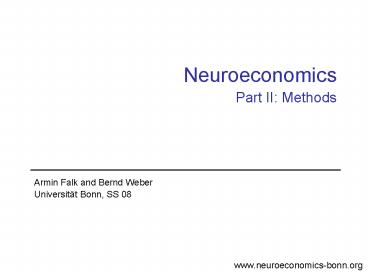Armin Falk and Bernd Weber - PowerPoint PPT Presentation
1 / 44
Title:
Armin Falk and Bernd Weber
Description:
Macroanatomy of the brain. Biology of Neurons (Microanatomy) - neurons and glial cells ... Rostral-Caudal (front-back) anterior-posterior. Dorsal-Ventral (up down) ... – PowerPoint PPT presentation
Number of Views:75
Avg rating:3.0/5.0
Title: Armin Falk and Bernd Weber
1
Neuroeconomics Part II Methods
- Armin Falk and Bernd Weber
- Universität Bonn, SS 08
www.neuroeconomics-bonn.org
2
Books
3
Overview
Macroanatomy of the brain Biology of Neurons
(Microanatomy) - neurons and glial cells -
electrochemical basis of nerve function -
chemical basis of nerve communication Functional
Neuroanatomy (systems of the nervous system) -
Somatosensory System - Motor System - Visual
System - Limbic System - Reward System
4
Neuroanatomy
5
Division of the nervous system
- Central Nervous System
- Peripheral Nervous System
Brain
Spinal Cord
Cranial Nerves
Spinal Nerves
Peripheral Ganglia
6
Central Nervous System (CNS)
- 7 Main Parts of the CNS
- Spinal Cord
- Medulla oblongata
- Pons
- Cerebellum
- Midbrain
- Diencephalon
- Cerebrum
7
Directions in the nervous system - Axes
Orientation Axes in the brain Rostral-Caudal
(front-back) ? anterior-posterior Dorsal-Ventr
al (up down) Lateral-Medial (sideways mid)
8
Directions in the nervous system - Planes
9
Development of the CNS
10
Maturation of the CNS
Brain weight at birth 400 g At 2 years 1000
g Adult 1500 g Maturation is mostly based on
differentiation of nerve-cell connectivty
11
The lobes of the brain
- Four lobes of the brain
- Frontal lobe
- Parietal lobe
- Occipital lobe
- Temporal lobe
12
Internal Structures Subcortical
- Some structures cannot be seen from the surface
of the brain, i.e. - subcortial structures, e.g.
- Basal ganglia
- insular cortex
- medial temporal lobe
- ventricles
13
From macro- to microanatomy
Difference of white- and grey matter Grey
matter nerve cell bodies White matter nerve
fibres
Coronal section of a macaque brain
14
Histological organization of grey matter
The cortex is arranged out of 6 histological
layers which have distinct processing and
input-/output functions
15
Brodmann areas histological division of the
brain
Based on the differences in layer organization,
the brain has been mapped into 52 areas by
Korbinian Brodmann 1909
16
Function of different layers
Neurons in different layers have distinct
projection characteristics
17
Interneurons modulate Projection neurons
Interneurons do not project to other areas of the
brain, but modulate the activity of primary
projection neurons either inhibitory or
excitatory.
18
Microanatomy
The brain consists of about 100 billion cells.
Nerve cells (neurons)
Glia (glial cells)
Control of environment of neurons
processing units
19
Nerve cells (neurons)
20
Sketch of a neuron
Nucleus
Axons
Dendrites
Dendrites
Myelin
- Dendrites -- Input
- Cell body (soma) -- Integration
- Axon -- Output
21
Structure of neurons - Dendrites
At dendrites, the neurons recieve input via axons
of other neurons at synapses
dendritic spine
22
Structure of neurons - Soma
In the soma of the cells, the cell nucleus is
located (containing the DNA, i.e. genetic code)
the synthesis of the proteins (within ribosomes
and endoplasmatic reticulum) as well as energy
production (mitochondria) are performed.
23
Structure of neurons - Axon
The axon transmits the information electrically
from the soma to the synapses it is surrounded
by myelin that insulate the axon, provided by
oligodendrocytes (glial cells)
24
Sketch of a neuron
Nucleus
Axons
Dendrites
Dendrites
Myelin
- Dendrites -- Input
- Cell body (soma) Integration protein
production, genes, energy production - Axon -- Output
25
Electrical properties of neurons
extracellular
intracellular
The cell membrane isolates the intracellular from
extracellular space
26
(No Transcript)
27
Electrical properties of neurons
The membrane potential
extracellular
difference of -70 mV
intracellular
In the resting state, the intracellular space
contains more negative ions than the
extracellular space
28
Ion channels connect the intra- and extracellular
space
Opening of ion channels lead to a flux of ions
through the membrane and to a change of the
membrane potential
29
Different types of ion channels
30
The action potential
The action potential is generated by ion flux
through voltage gated channels
All or nothing principle!!
31
Propagation of the action potential
32
Synapse Communication between neurons
33
Synapse Communication between neurons
34
Synapse Communication between neurons
Presynaptic vesicles with neurotransmitter
Released transmitter
Transmitter binds to receptor
Transmitter-Resorption from synaptic cleft
Na
35
Excitatory and Inhibitory Synapses
Excitatory postsynaptic potential (EPSP)
Inhibitory postsynaptic potential (EPSP)
Depending on the neurotransmitter and the
receptor, the postsynaptic potential can be
excitatory or inhibitory
36
Important Neurotransmitters
- Dopamine
- Epinephrine
- Norepinephrine
- Acetylcholine
- Serotonine
- Glycine
- GABA
- Glutamate
37
Two forms of integration of information
38
EPSC at dendrite can lead to action potential
39
Effect of inhibition on excitation
40
Glial cells
oligodendrocytes
astrocytes
41
Astrocytes
Astrocytes connect the extraneuronal space with
the blood vessels
42
Oligodendrocytes
Oligodendrocytes sheat the axons of the neurons
to increase conductance of action potential
43
Summary neuronal communication
- intracellular electrical transmission of
information (action potential) - neurons communicate via biochemical transmission
(neurotransmitters and receptors) - integration of information in neurons by means
of spatial and temporal summation
44
Plasticity of the brain building of synapses

